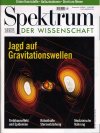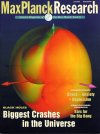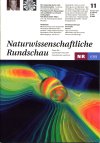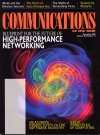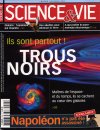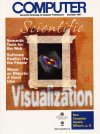Activities & Interests in General Relativity
Raytracing using hyperbolic light paths (1992)
Presented during the Alpbach Summer School 1992.Unfortunately, I have no idea where I put the images from this ancient presentation...
Simulation of a Black Hole by Raytracing (1993/1994)


In this simulation it is shown what happens to a natural scene when one of these objects where a Black Hole. The bending of the light rays around a `soccerball-like' Black Hole makes normally invisible parts of the involved objects to come into view. Basic principles of gravitational lensing are demonstrated on ordinary objects and the meaning of the Einstein ring is explained also.
Published in:
 |
F.W.Hehl, R.A.Puntigam, H.Ruder (Eds.) Relativity and Scientific Computing Computer Algebra, Numerics, Visualization ISBN 3-540-60361-1 Springer Verlag Berlin Heidelberg New York |
 |
PM 5/97 (Peter Moosleitners interessantes Magazin), `Relativitätstheorie: Jetzt macht der Computer sie sichtbar' |
Voids (Diplomarbeit, 1997)
Der Einfluß der kosmologischen Konstanten auf die Vakuumblasen im expandierenden UniversumVoids (Diploma thesis, 1997)
The Influence of the Cosmological Constant on the Voids in the Expanding Universe (german only)The Tolman dust metric with cosmological constant was used to model a spherically symmetric inhomogenious universe. Small density perturbations at the beginning of the matter dominated phase are traced during their evolution within the expansion of the universe and their final properties are compared in the standard model (using an Hubble constant of 50km/s/Mpc, zero cosmological constant and critical density) to the world model by Wolfgang Priester et.al.
An interactive interface for computing the Friedmann-Lemaitre universe and the inhomogenius dust cosmos is also available here.
The Black Earth (1997)
 or: The Day, when Earth became a Black Hole
or: The Day, when Earth became a Black Hole
For an intuitive insight into the curvature of space due to the gravitational field, it is suitable and impressive to see the effects of curved space act on well known objects. This simulation series was made to demonstrate the visual effect that would occur if Earth became a Black Hole from one day to another. Special attention was given to demonstrate the properties of the Photon Orbit, where light rays may orbit the central on an perfect circle.
ART - a project for the interactive visualization and exploration of numerically found curved spacetimes (1997-2005)
Numerical solutions cannot be investigated on just `a sheet of paper' like analytical solutions. These modern solution methods thus require three and four-dimensional visualization techniques.
This is the goal of the ART project,
a collaboration project between ZIB and AEI.
New Frontiers in Relativistic Visualization (2005-2008)
At Louisiana State University
More to come here...
Publications
Articles and images from these projects appeared in many journals and books.| The first grazing collision of two black holes
was performed in June 1999 at NCSA.
This dataset showed very clear structures and its visualizations were
spreading around soon. The central part displays the color-coded
horizons.
The original version used white/yellow/red colors for depicting
high/medium/low intensity of the gravitational radiation around. Some years
later, I made a more dynamically looking version for the
magazine GEO which used a colormap with shades ranging from
red via yellow to green and blue. This image and its variants
is now used in many places.
The efforts of this 1999 visualization marathon are described in SuW Special 6 Gravitation (German). |
SuW Special 6 Gravitation |
||||
|
Gravity from the Ground Up Bernard Schutz |
The Future of Theoretical Physics an Cosmology Celebrating Stephen Hawking's 60th Birthday |
December 2000 Issue |
|||
Access Magazine 1999 NCSA/Alliance |
Max Planck Research MPG 1999 |
Naturwissenschaftliche Rundschau 11/2005 |
|||
LIGO Folder |
Communications of the ACM Vol. 46, No. 11, Nov 2001 |
Science & Vie No. 1011, Nov 2002 |
|||
IEEE Computer Dec. 1999 |
|||||
| Timelike Geodesics in the Kerr Spacetime.
Trajectories of test particles in the vicinity of rotating
black hole yield aesthetically pleasing regular pattern.
The computation is based on the CACTUS
thorn TimeGeodesics, developed by Miguel Alcubierre.
It has been equipped with an network interface to allow remote
visualization.
The visual results are appealing to scientists as well as to artists. |
Visualization and Processing of Tensor Fields Joachim Weickert, Hans Hagen; Springer Verlag |
Einstein Opera by Phase 7 |
|||
Nancy Walker |
|||||
|
Das Einstein-Fenster Markus Poessl |
Der Stern von Bethlehem in astronomischer Sicht Konradin Ferrari d'Occhieppo |
||||
-
 Blind Date -
Art meets Science;
an art exhibition initiated by the
Brandenburgischer Kunstverein,
on the topic "Event Horizon", together with
artist Susanne Weirich
Blind Date -
Art meets Science;
an art exhibition initiated by the
Brandenburgischer Kunstverein,
on the topic "Event Horizon", together with
artist Susanne Weirich
 TV Interview in german financial magazine "Frontal21", 12. November 2002,
Eichels schwarze Löcher
TV Interview in german financial magazine "Frontal21", 12. November 2002,
Eichels schwarze Löcher
- The GRG18 announcement poster contains lots of my images.
Further Recommendations:
-

 University of Tuebingen - Films & Movies on
Special and General Relativity
-
Special Relativity
and
General Relativity
Raytracing
University of Tuebingen - Films & Movies on
Special and General Relativity
-
Special Relativity
and
General Relativity
Raytracing
 Ray Tracing with Curved Light Beams
(done by Per Christian Ødegård)
- greatly, this page has appeared again after it was
hidden for a long time and Christian's mail was accidentally
moved automatically into my SPAM folder, but his thesis was such
excellent that I kept this link here to remind myself and
the rest of the world of this page.
Ray Tracing with Curved Light Beams
(done by Per Christian Ødegård)
- greatly, this page has appeared again after it was
hidden for a long time and Christian's mail was accidentally
moved automatically into my SPAM folder, but his thesis was such
excellent that I kept this link here to remind myself and
the rest of the world of this page.
 Virtual Trips to Black Holes and Neutron Stars
Virtual Trips to Black Holes and Neutron Stars
 Too close to a Black Hole
(Astronomy Picture of the Day November 27, 1995),
or via Black Hole Index
Too close to a Black Hole
(Astronomy Picture of the Day November 27, 1995),
or via Black Hole Index
 Black Hole Simulations
(Sam Hart, Arizona)
Black Hole Simulations
(Sam Hart, Arizona)
 Falling into a Black Hole
(Andrew Hamilton, Colorado)
Falling into a Black Hole
(Andrew Hamilton, Colorado)
 Null Geodesics Around a Kerr Black Hole
(Bo Milvang-Jensen, Denmark)
Null Geodesics Around a Kerr Black Hole
(Bo Milvang-Jensen, Denmark)
 Yahoo Black Hole Directory
Yahoo Black Hole Directory
 Andrew Howard - relativistic raytracing
Andrew Howard - relativistic raytracing
 Seeing Relativity
The Backlight Raytracer at the Austrial National University - best special
relativistic rendering seen so far!
Seeing Relativity
The Backlight Raytracer at the Austrial National University - best special
relativistic rendering seen so far!
 Relativistic raytracing of lattices
Relativistic raytracing of lattices
 The Light Cone (by Rob Salgado)
The Light Cone (by Rob Salgado)
 Web Course on Gravitational Waves (by Kip Thorne, Mihai Bondarescu and Yanbei Chen)
Web Course on Gravitational Waves (by Kip Thorne, Mihai Bondarescu and Yanbei Chen)
 Excellent Cosmology FAQ (by Ned Wright)
Excellent Cosmology FAQ (by Ned Wright)
 CarpetCode - Numerical Simulations of General Relativity
CarpetCode - Numerical Simulations of General Relativity

